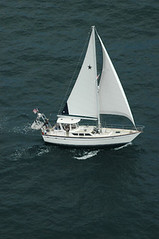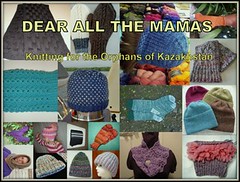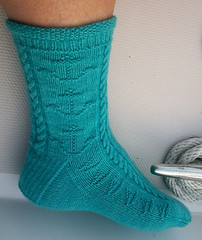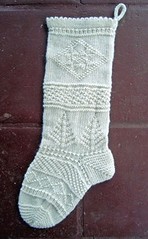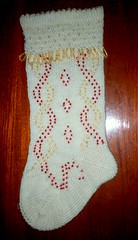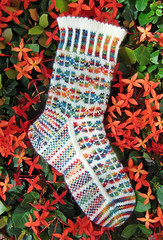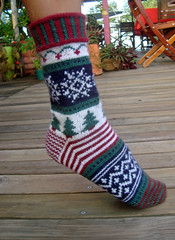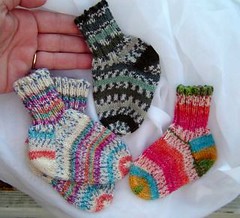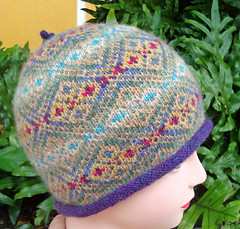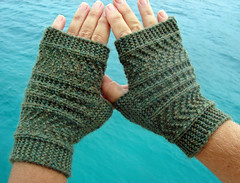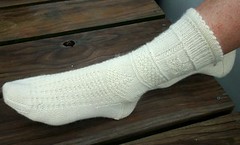
Thursday, February 18, 2010
Cholon Bay, Colombia
 Cartagena, Colombia November 11th, 2009:
Cartagena, Colombia November 11th, 2009: At long last, we hoisted the anchor and motored out of the bay of Cartagena towards the open seas. Our stay in Colombia was nearing the end after almost the entire 6 months our visas had allowed. Our destination that day was still in the country of Colombia, but we were officially checked out of the country with both immigration (passport stamps) and the port captain. In Latin American countries, all boats must receive permission from the local port captain to leave. The paperwork we get is called a zarpe. It states where we left from and the date, and where (what country and specific port) we are travelling to. Then we must present our zarpe to the next port captain we encounter (more official stamping of papers, Latin Americans love official stamping of documents and collecting the fees to do so).
There are two ways to exit and or enter the Cartagena Bay by boat – “Boca Chica” and “Boca Grande”. We chose Boca Chica because Boca Grande can be tricky due to the underwater wall across the channel. Yep. The Spanish built this stone wall hundreds of years ago to prevent pirate ships (the English) from attacking and sacking Cartagena. There is a gap in the wall now, but woe be to the sailor who mis-navigates! We decided to take our chances with the Boca Chica gap which has more clearance, but also has its own risks.
Above is a photo we took as we passed, of the historic Spanish fortress that still stands on both sides of the Boca Chica entrance. Sailors don’t need to worry about the British pirates anymore, yet now it’s the loc
 al Colombian pirates that are a risk. As we motored through the murky waters of this gap on our way out to sea we were approached by two boys in a canoe shouting for “money”. No real threat – they were paddling and we had the Perkins 350 engine chugging. But, just 2 weeks later a sailboat was forced away from the deep channel and onto the shoals by men with guns in a boat. The sailboat was looted in record time. Guess the boys we encountered were just playing/practicing for what would be their future “careers”.
al Colombian pirates that are a risk. As we motored through the murky waters of this gap on our way out to sea we were approached by two boys in a canoe shouting for “money”. No real threat – they were paddling and we had the Perkins 350 engine chugging. But, just 2 weeks later a sailboat was forced away from the deep channel and onto the shoals by men with guns in a boat. The sailboat was looted in record time. Guess the boys we encountered were just playing/practicing for what would be their future “careers”.Right off of the coast from Cartagena are the Rosarios which are a set of islands popular with local tourists. Unfortunately, the wind direction that day would make the ancho
 rage unsafe and uncomfortable so we headed over to the bay of Cholon instead. Although our entire trip was only about 4 hours long that first day, we arrived into a totally different world. Sure, we were still in Colombia, but oh! viva la difference! These series of mangrove covered islands are vaguely attached by dirt road to the mainland by a peninsula. “Vaguely” because at one point vehicles must use an unreliable and infrequent f
rage unsafe and uncomfortable so we headed over to the bay of Cholon instead. Although our entire trip was only about 4 hours long that first day, we arrived into a totally different world. Sure, we were still in Colombia, but oh! viva la difference! These series of mangrove covered islands are vaguely attached by dirt road to the mainland by a peninsula. “Vaguely” because at one point vehicles must use an unreliable and infrequent f erry to cross a river.
erry to cross a river.Thus, the islands surrounding the bay of Cholon is sparsely inhabited and have just a small village called Baru about 4 miles from the anchorage. Only the vacation homes of rich Colombians, usually occupied only by the resident caretaker, dot the shores. At night we could see the lights of the city of Cartagena in the distance (remember we only travel at about 5mph) but all around us it was dark and the sky was filled with brilliant stars. The breezes from the ocean were marvelously cooling and the water was warm (82 degrees)
 and clean. After a hot, steamy summer in Cartagena, the breeze was so very welcome.
and clean. After a hot, steamy summer in Cartagena, the breeze was so very welcome.We anchored in the bay where there were a couple of other cruising sailboats and quickly reconnected with old friends and made new. We had planned to spend only a few days here shaking down the boat before continuing our journey, but the charms of Cholon captured us and we ended up spending a couple of weeks. So here sat Niki Wiki.
Sure, being this remote meant that we didn’t have internet service but the trade off was worth it. The anchorage was protected from the sea swells and waves by the low-lying islets and the larger peninsula so the boat rested quietly in the water. In the mornings we laughed at the noisy flocks of parrots flying ab
 out in the trees up on the hills. Each evening, just before sunset we welcomed the flocks of egrets who came home to roost for the night in the mangroves.
out in the trees up on the hills. Each evening, just before sunset we welcomed the flocks of egrets who came home to roost for the night in the mangroves.Every day some of the local folks would paddle up to our boat and offer items for sale. My favorite goodies w
 ere some coconut candy, well, lumps which were a mixture of grated fresh coconut and a local dark brown molasses-rich sugar. Yummy! I also bought a small carved stone box. I just love little boxes.
ere some coconut candy, well, lumps which were a mixture of grated fresh coconut and a local dark brown molasses-rich sugar. Yummy! I also bought a small carved stone box. I just love little boxes.So, we spent the days swimming off of the boat in the clean waters of the bay. Well, not really swimming, more like we floated with our pool noodles. As long as we were in the water, we scrubbed more of the nasty barnacle growth off of the bottom of the boat with scotchbrite pads. Although we had had the bottom cleaned TWICE a month in Cartagena while we were there, the growth rate for these little creatures is dang fast in this area. Within days you can see and feel new little barnacles! Our shoulders were over-stressed and stiff from all of this work!

The TREASURE of CHOLON
Well, there used to be treasure in these parts – Spanish gold stolen from the local Indians. But now the treasure here is a friendly couple who live on the bay of Cholon – Robert and Carmen of the land-based house “Crow’s Nest”. Robert (an ex-Los Angeles motorcycle cop) and his Colombian wife share their knowledge of the area as well as their beautiful house up on the hill with the cruisers who pass this way.

They also own a large shrimper boat (m.v. Manatee) anchored in the bay which they are refurbishing for future use as a hostel for adventurous folks. In the meantime, Manatee functions as the focal point for cruiser socializing with frequent BYOB “Happy Hours” onboard. Yep, those are cruisers up on top of the
 deck cover of Manatee. Note their official male cruising uniforms of t-shirt, hat, shorts, flip-flops or Keens boat sandals, tans, and a beer or other adult beverage in one hand. Oh yeah...we were happy all right.
deck cover of Manatee. Note their official male cruising uniforms of t-shirt, hat, shorts, flip-flops or Keens boat sandals, tans, and a beer or other adult beverage in one hand. Oh yeah...we were happy all right.For Thanksgiving, Robert and Carmen hosted a lavish potluck at their home complete with turkey, dressing, and all the fixings! For our contribution to the feast, I baked yeast rolls for the crowd. It was breezy enough that I turned on the oven for the first time in 6 months.
 The view from Crow’s Nest is stunning and 360 degrees around! Although there is electricity available on the peninsula, there is no water service. So they rely upon and store the frequent rains during the su
The view from Crow’s Nest is stunning and 360 degrees around! Although there is electricity available on the peninsula, there is no water service. So they rely upon and store the frequent rains during the su mmer months. Water conservation is a must! The roof is set up to collect the runoff and then flow into a large underground cistern. Carmen has planted flowers, vegetables, herbs and many different tropical fruit trees such a
mmer months. Water conservation is a must! The roof is set up to collect the runoff and then flow into a large underground cistern. Carmen has planted flowers, vegetables, herbs and many different tropical fruit trees such a s limes, papaya, and mango around the property. Check out this cool catapiller we spotted on the hike up the hill to the Crow's Nest - it was about 2" long!
s limes, papaya, and mango around the property. Check out this cool catapiller we spotted on the hike up the hill to the Crow's Nest - it was about 2" long!On the way to one of the events up at the Crow’s Nest, Jonesy dropped his (high fashion) clip-on sunglasses into the water while climbing up onto the dock. He tried to scoop them up with a dingy oar, but with no success. We decided to continue the search the next morning when he could get into the water. Why so
 much effort for a $5 pair of sunglasses? Because he wouldn’t be able to buy another pair for at least 3 months or until we get up to the cities of central Panama where there are stores. Plus, he he really needs and likes them (even though he looks like the Johnny 5 robot from the movie “Short Circuit” when he flips them up, and even scares little children).
much effort for a $5 pair of sunglasses? Because he wouldn’t be able to buy another pair for at least 3 months or until we get up to the cities of central Panama where there are stores. Plus, he he really needs and likes them (even though he looks like the Johnny 5 robot from the movie “Short Circuit” when he flips them up, and even scares little children).
So while Jonesy searched for his sunglasses, his lovely assistant
 er belly on the dock and took photos of the sea life a
er belly on the dock and took photos of the sea life a ttached to the pilings, and marveled at the bizarre reflection of her feet on the water as seen from the underneath the dock looking back from the other side. All the while
ttached to the pilings, and marveled at the bizarre reflection of her feet on the water as seen from the underneath the dock looking back from the other side. All the while  . The colors of the sponges were amazing – mint greens, pitch black, bright oranges and reds.
. The colors of the sponges were amazing – mint greens, pitch black, bright oranges and reds.Finally - success! The water looks muddy
 because he had to drag his hands through the yucky bottom to find the sunglasses. But he was sure a happy cruiser to have them back. The climb out of the water using the roots of the nearby mangrove trees was not pretty though. But there was no blood.
because he had to drag his hands through the yucky bottom to find the sunglasses. But he was sure a happy cruiser to have them back. The climb out of the water using the roots of the nearby mangrove trees was not pretty though. But there was no blood.Unfortunately, theft was an ever present threat so we had to raise the dinghy each night with the halyard and run locking cables through everything on deck (kayak, diesel jugs, gas cans, spare anchors, etc.) or it could disappear – day or night. No, this wouldn’t prevent a determined thief, but it does make it harder for the casual/opportunistic individual who is too poor to own a set of bolt cutters (or hasn’t stolen these yet).
During the day we all kept a vigilant eye on each others’ boats. At night, we ran spontaneous “Spotlight Tag”. This exercise was usually started by Robert up on the hill at Crow’s Nest. He would aim his search light out over the anchorage and slowly scan for suspicious vessels. Of course, we would see his light, especially as it moved over our boat. So next, we or another boat, would get our light out and do the same from our boat. Hopefully we prevented some loss.
But, Robert’s dinghy engine was stolen one night while we were there. Even tho
 ugh he had a hired man stay on the shrimp boat at night, the dinghy was left in the water and the engine was gone. The hope was that it would be simply held for ransom and returned after a payment was made. But this didn’t happen. Ah…life in Latin America. Even property is kidnapped for ransom. We’ve since heard that there has been an escalation of theft from the cruisers at Cholon. Of course, this deters many cruisers from visiting the area. So far though, we haven’t heard of any violence.
ugh he had a hired man stay on the shrimp boat at night, the dinghy was left in the water and the engine was gone. The hope was that it would be simply held for ransom and returned after a payment was made. But this didn’t happen. Ah…life in Latin America. Even property is kidnapped for ransom. We’ve since heard that there has been an escalation of theft from the cruisers at Cholon. Of course, this deters many cruisers from visiting the area. So far though, we haven’t heard of any violence.But, the beautiful setting, including this swim-up bar and seafood restaurant on a sandbar, make the risks worth taking. This place was packed with vacationers over a local 5-day holiday and the tide was much lower then too.
KNITTING

Of course there was a whole lotta knitting taking place aboard. I decided that I would knit those pesky "second socks" to match the lonely single socks in my knitting bags (yes plural). When I'm designing, I only knit one sock for the photo then dash over to another project. It was time to slow down and finish up some pairs. I also decided to concentrate my knitting for the kids in the orphange in Akkol, Kazakhstan.
This first pair are large adult-sized socks knit wi
 th a Regia self-patterning yarn. Quickly I realized that I had knit a pair of socks last year with the same yarn! So I added some black stripes to the leg and toes so that the socks wouldn't get mixed up in the laundry.
th a Regia self-patterning yarn. Quickly I realized that I had knit a pair of socks last year with the same yarn! So I added some black stripes to the leg and toes so that the socks wouldn't get mixed up in the laundry.Next up - another adult-sized pair of socks using Online Supersocke100 Sierra-Country, Sortierung 46 color #575 (see? I do keep notes!). This yarn is really nice to work with and knits up a soft, warm sock. Another knitting cruiser told me that her mother in Germany uses a double strand of yarn fo
 r the cast-on and the first 3 rounds. This area gets a lot of wear and often gets frayed. So, I started using this for the socks meant for the kids at the orphanage. Here's
r the cast-on and the first 3 rounds. This area gets a lot of wear and often gets frayed. So, I started using this for the socks meant for the kids at the orphanage. Here's a close-up photo showing the heavier stitches at the top of the cuff.
a close-up photo showing the heavier stitches at the top of the cuff.Third, I finished up another adult-sized pair of socks w
 ith yarn that I had overdyed with black. The base yarn was an Opal Masterpiece self-patterning yarn which I thought was simply ghastly. I don't like the Masterpiece series of colorways at all - they are blotchy and the colors are horific. But the base yarn is a great quality so over-dying was the answer.
ith yarn that I had overdyed with black. The base yarn was an Opal Masterpiece self-patterning yarn which I thought was simply ghastly. I don't like the Masterpiece series of colorways at all - they are blotchy and the colors are horific. But the base yarn is a great quality so over-dying was the answer.Finally, I finished the second sock for my version of "Clouds" from the Six Sox Knitalong group on Yahoo. These are in a 6-ply Regia yarn and the pattern is worked with lots, and lots, and lots of short rows. I like the end result, but did not enjoy knitting them and I suck at short row heels. Yep these will go to the Akkol Orphanage too.
Okay - that's enough - more later!
Comments:
<< Home
Terry, there are at least two lakes in Michigan that harbor two camera lenses and one pair of prescription glasses of mine. Good to hear you are doing fine. I love your "cloud socks" but I also dislike short rows and short row heels do not fit me well. So my daughter got my clouds socks. With what color did you overdye the Opal. I figure they are the bluish socks. Do you remember what colorway the wool was originally. I love Opal; it wears like iron. Renate S from Michigan
So glad to hear you guys are OK... I had heard new of some off shore trouble around Cartagena just after you had sailed from there. Maybe I should go to someplace that has not internet so I can get my knitting done.
Great post. I'm wondering if you guys ever considered carrying a weapon like a gun on board, for those just in case scenarios. Would love to hear your thoughts on that.
So glad to hear you are well and enjoying life. What great stories you have of your sailing adventures. Thanks for the update. I'm looking forward to more!
Hi Guys!
I'm really jealous of you now. Still stuck on the Mexico Gold Coast but want to get some real miles under this keel. I think one more trip up to San Carlos and I'll be suicidal! Glad you're still well and enjoying the life. Maybe we'll catch up some day...
Post a Comment
I'm really jealous of you now. Still stuck on the Mexico Gold Coast but want to get some real miles under this keel. I think one more trip up to San Carlos and I'll be suicidal! Glad you're still well and enjoying the life. Maybe we'll catch up some day...
<< Home


